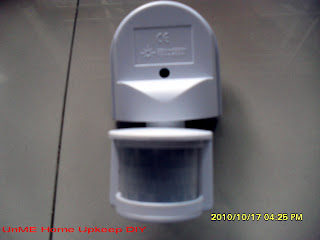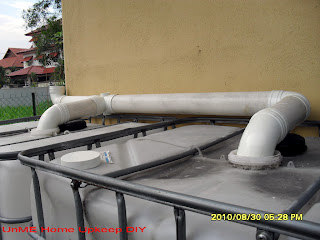 |
| This sensor adaptor from " AVA" Taiwan, is fixed to a table lamp This cost RM55.00. Just take out the bulb and fix this adaptor into the bulb holder. Then, fix the bulb on top of the adaptor. |
Do you ever have a strange notion in the midst of sleeping? A state of mind that is vague and uncertain of oneself. One is not sure if one is dreaming or in a semi conscious state or is fully awake. I have this experience whenever I have the urge of easing myself in the middle of the night. Yet, I wasn’t sure if I am in a sub-conscious state of mind, dreaming or actually awake. My hand moves by reflex action to locate the light switch beside the bed. In the darkness, I occasionally push down the alarm clock and the glass ornaments on the side table of the bed.
 |
| Close up of the sensor. The red blinking light indicates motion is detected. |
That was history. I have overcame the problem with the PIR Sensor (Passive Infra-Red Motion Sensor) way back in 1988 I bought the first PIR sensor light for RM550 ringgits. This was a proud Malaysian invention by two engineers from Sitiawan.
 |
| This is my first Motion Sensor table lamp purchased in 1988 for RM550.00. This motion sensor was invented by two Malaysians. The first generation motion sensor lamp by NOVAL. |
Since then, I cannot go on without the PIR sensor light.
 |
| This is the second generation sensor lamp by Noval (Malaysian Invention) |
Now, my house is equipped with PIR sensor light in every rooms and at every corners of the house.. I don’t have to grope in the darkness anymore.. I just simply walk around the house at night and the light switch on automatically and switch off by itself after the set timing (2 to 15 minutes) expires.
 |
| This is a sensor adaptor mounted on a table lamp This is "AVA" brand sensor made in Taiwan The cost is RM55.00 |
Most PIR motion sensors are also equipped with a photo sensor. The photo sensor can be set to the required degree of brightness or darkness (called LUX) to activate the motion sensor. If one set the LUX to absolute darkness, the motion sensor will only activate and switch on the light when the surrounding is in total darkness and motion is detected.
There is also a built-in timer to set the duration of on/off lighting The motion sensor will switch off the light after the set duration expires, unless further motion is detected.
 |
| This "Plug & Play" sensor adaptor fits any standard E27 screw-type bulb holder |
Some PIR Motion sensor light are sold in ‘Plug and Play” package. They come in the form of table lamp, stand lamp, wall light and ceiling light. Just plug into a 3-pin socket or connect to AC wire (Live and Nuetral) to operate. One can also purchase the PIR motion sensor gadget separately and connect to the exiting light fixtures.
The PIR motion sensor light are available at most electrical lighting outlets. The price of this gadget has reduced from RM550 in 1988 to below RM50.00 (made in China) now.
 |
| This cost only RM39.00. China-made "Nesly" wall sensor light. Real value for money. I put this in my kitchen. |
The more advance PIR sensor gadget in USA and EU has a built-in thermal sensor. This more advanced gadget can detect the presence of warm-blooded mammal. This is used to control lighting, heater and air-conditioner in home and office. As long as body heat is detected, the sensor will switch on the appliances or fixtures connected to the sensor. And of course, this come with a price.
 |
| This gadget is suitable for indoor use only. The cost ranging from RM39.00 to RM90.00 depending on the brand, PDL, MK, Philips or China made. |
See how I fixed the motion sensor to my existing ceiling light.
Another outdoor sensor.










































